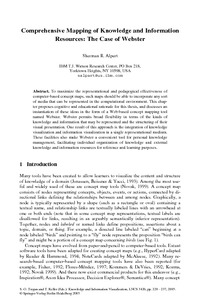Comprehensive Mapping of Knowledge and Information ResourcesThe Case of Webster
Sherman R. Alpert
Zu finden in: Knowledge and Information Visualization (Seite 220 bis 237), 2005
|
 |
 Diese Seite wurde seit 2 Jahren inhaltlich nicht mehr aktualisiert.
Unter Umständen ist sie nicht mehr aktuell.
Diese Seite wurde seit 2 Jahren inhaltlich nicht mehr aktualisiert.
Unter Umständen ist sie nicht mehr aktuell.
 Zusammenfassungen
Zusammenfassungen
 This chapter is based on the simple premise that concept maps are ideal vehicles
for organizing and integrating both elemental knowledge of a domain and associated
information and information visualizations; this premise, however, relies on the
equally simple assumption that computer-based concept maps should be able to incorporate
any knowledge or informational artifacts in any medium that can be digitally
represented. This includes static, passive, and interactive graphics and animations,
written and spoken text, video, audio, and so on. Such media of course thereby
include static, passive, and interactive information visualizations. This chapter describes
a concept map tool with such capabilities, named Webster (Alpert, 2003; Alpert
& Grueneberg, 2000, 2001).
This chapter is based on the simple premise that concept maps are ideal vehicles
for organizing and integrating both elemental knowledge of a domain and associated
information and information visualizations; this premise, however, relies on the
equally simple assumption that computer-based concept maps should be able to incorporate
any knowledge or informational artifacts in any medium that can be digitally
represented. This includes static, passive, and interactive graphics and animations,
written and spoken text, video, audio, and so on. Such media of course thereby
include static, passive, and interactive information visualizations. This chapter describes
a concept map tool with such capabilities, named Webster (Alpert, 2003; Alpert
& Grueneberg, 2000, 2001). To maximize the representational and pedagogical effectiveness of
computer-based concept maps, such maps should be able to incorporate any sort
of media that can be represented in the computational environment. This chapter
proposes cognitive and educational rationale for this thesis, and discusses an
instantiation of these ideas in the form of a Web-based concept mapping tool
named Webster. Webster permits broad flexibility in terms of the kinds of
knowledge and information that may be represented and the structuring of their
visual presentation. One result of this approach is the integration of knowledge
visualization and information visualization in a single representational medium.
These facilities also make Webster a convenient tool for personal knowledge
management, facilitating individual organization of knowledge and external
knowledge and information resources for reference and learning purposes.
To maximize the representational and pedagogical effectiveness of
computer-based concept maps, such maps should be able to incorporate any sort
of media that can be represented in the computational environment. This chapter
proposes cognitive and educational rationale for this thesis, and discusses an
instantiation of these ideas in the form of a Web-based concept mapping tool
named Webster. Webster permits broad flexibility in terms of the kinds of
knowledge and information that may be represented and the structuring of their
visual presentation. One result of this approach is the integration of knowledge
visualization and information visualization in a single representational medium.
These facilities also make Webster a convenient tool for personal knowledge
management, facilitating individual organization of knowledge and external
knowledge and information resources for reference and learning purposes. Dieser Text erwähnt ...
Dieser Text erwähnt ...
 Personen KB IB clear | David H. Jonassen , Stephen M. Kosslyn , Jill H. Larkin , M. R. Quillian , Herbert Simon | ||||||||||||||||||||||||||||||||||||
 Begriffe KB IB clear | cognitive load theory (CLT)
,  Computer Computer computer
, Concept MapConcept Map
, Informationinformation
, information visualizationinformation visualization
, computer
, Concept MapConcept Map
, Informationinformation
, information visualizationinformation visualization
,  Management Management management management
| ||||||||||||||||||||||||||||||||||||
 Bücher |
| ||||||||||||||||||||||||||||||||||||
 Texte |
|
 Dieser Text erwähnt vermutlich nicht ...
Dieser Text erwähnt vermutlich nicht ... 
 Nicht erwähnte Begriffe | Concept Mapping Software, knowledge visualization |
 Zitationsgraph
Zitationsgraph
 Zitationsgraph (Beta-Test mit vis.js)
Zitationsgraph (Beta-Test mit vis.js)
 1 Erwähnungen
1 Erwähnungen 
- Interaktive Maps - Zugriffsinstrumente auf große Textmengen (Raja Gumienny) (2007)


 Anderswo finden
Anderswo finden
 Volltext dieses Dokuments
Volltext dieses Dokuments
 |  Comprehensive Mapping of Knowledge and Information Resources: Artikel als Volltext bei Springerlink ( Comprehensive Mapping of Knowledge and Information Resources: Artikel als Volltext bei Springerlink ( : :  , 207 kByte; , 207 kByte;  : :  Link unterbrochen? Letzte Überprüfung: 2021-03-21 Letzte erfolgreiche Überprüfung: 2019-10-11) Link unterbrochen? Letzte Überprüfung: 2021-03-21 Letzte erfolgreiche Überprüfung: 2019-10-11) |
 Anderswo suchen
Anderswo suchen 
 Beat und dieser Text
Beat und dieser Text
Beat war Co-Leiter des ICT-Kompetenzzentrums TOP während er Dieser Text ins Biblionetz aufgenommen hat. Die bisher letzte Bearbeitung erfolgte während seiner Zeit am Institut für Medien und Schule. Beat besitzt kein physisches, aber ein digitales Exemplar. Eine digitale Version ist auf dem Internet verfügbar (s.o.). Es gibt bisher nur wenige Objekte im Biblionetz, die dieses Werk zitieren.








 (
(

 Biblionetz-History
Biblionetz-History